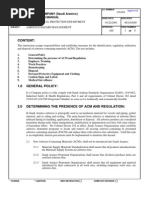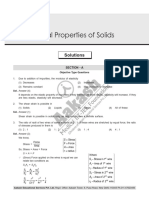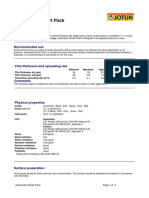Chemical Hazard Bulletin: OPT D 1127
Chemical Hazard Bulletin: OPT D 1127
Uploaded by
HaleemUrRashidBangashCopyright:
Available Formats
Chemical Hazard Bulletin: OPT D 1127
Chemical Hazard Bulletin: OPT D 1127
Uploaded by
HaleemUrRashidBangashOriginal Title
Copyright
Available Formats
Share this document
Did you find this document useful?
Is this content inappropriate?
Copyright:
Available Formats
Chemical Hazard Bulletin: OPT D 1127
Chemical Hazard Bulletin: OPT D 1127
Uploaded by
HaleemUrRashidBangashCopyright:
Available Formats
Chemical Hazard Bulletin
CHB: 1359
OPT D 1127
INGREDIENTS CAS NO % 8HR OEL
xylene 1330-20-7 5-15 350 mg/m3
1,2,4-trimethyl benzene 95-63-6 25-35 -
petroleum naphtha Not Available 15-25 -
block polymer resin Not Available NotSpec. -
UN No: 1993 NFPA Rating:
Hazchem Code: •3Y 0: Minimum
DG Class: 3 1: Low
Subsidiary Risk: Not Applicable 2: Moderate
Packing Group: III 3: High
Poisons Schedule: Not Applicable 4: Extreme
HEALTH HAZARD INFORMATION PROPERTIES
Does not mix with water.
Floats on water.Flammable.
Harmful by inhalation and in contact with skin. EMERGENCY
Acute Health Irritating to eyes, respiratory system and skin.
Effects: HARMFUL-May cause lung damage if swallowed.
Vapours may cause drowsiness and dizziness.
PRECAUTIONS FOR USE FIRST AID
Give water (if conscious). Seek medical advice.
Swallowed: Do NOT give milk or oil.
Do NOT give alcohol.
Appropriate Eye: Wash with running water.
engineering Local Exhaust Ventilation recommended.
Remove contaminated clothing. Wash with soap &
controls: Skin:
water.
Glasses: Consider chemical goggles.
Fresh air. Rest, keep warm. If breath shallow, give
Gloves: 1.PE/EVAL/PE 2.VITON 3.PVA Inhaled:
oxygen. Medical attention.
Type A Filter of sufficient capacity. (AS/NZS 1716 Evaluate for respiratory distress. Consider lavage
Advice To
Respirator: & 1715, EN 143:2000 & 149:2001, ANSI Z88 or with cuffed tube. NO adrenalin.
Doctor:
national equivalent)
Fire Fighting: Foam.
Storage and Store in cool, dry, protected area.
Restrictions on Storage apply. Refer to Full Report. Eliminate ignition sources.
Transportation: Spills and
Prevent from entering drains.
Fire/Explosion Flammable. Disposal:
Contain spillage by any means.
Hazard: Toxic smoke/fumes in a fire.
Toxic to aquatic organisms. SAFE STORAGE WITH OTHER CLASSIFIED CHEMICALS
May cause long-term adverse effects in the
aquatic environment.Use appropriate container to
Environment:
avoid environmental contamination.
Avoid release to the environment. Refer to special
Explosive Toxic Radioactive Oxidizing
instructions/Safety data sheets.
x x x x
x — Must not be stored together
For further information call Environmental Protection: 880-9714 (DH) or 427-1535 (JID). For proper disposal methods and locations for the
chemical or chemical contaminated material, contact the Environmental Engineering Division on 880-9754
You might also like
- Aramco Emergency PlanDocument1 pageAramco Emergency Planengrabbas75100% (1)
- CHB en PDFDocument173 pagesCHB en PDFKarim Wasi100% (2)
- Safety Data Sheet Nitomortar Tc2000 Base: Revision Date: 26/06/2019 Revision: 0Document20 pagesSafety Data Sheet Nitomortar Tc2000 Base: Revision Date: 26/06/2019 Revision: 0usman khalid50% (2)
- Lifesaving Rules BookletDocument20 pagesLifesaving Rules BookletDLPS HSENo ratings yet
- FRCGuideDocument7 pagesFRCGuideHaleem Ur Rashid Bangash0% (1)
- GI 2.709 Gas Testing PDFDocument12 pagesGI 2.709 Gas Testing PDFMANI DEEP75% (4)
- Health Hazards: Chemical Hazard Bulletin No. 49Document1 pageHealth Hazards: Chemical Hazard Bulletin No. 49shinto LawrenceNo ratings yet
- Content:: Saudi Arabian Oil Company (Saudi Aramco) General Instruction ManualDocument16 pagesContent:: Saudi Arabian Oil Company (Saudi Aramco) General Instruction Manualbryan100% (1)
- ABRO Spray Paint PDFDocument6 pagesABRO Spray Paint PDFAnonymous QQZcso67% (9)
- Attachment J Contractor Inspection Checklist GI 298 - 010 - WeeklDocument10 pagesAttachment J Contractor Inspection Checklist GI 298 - 010 - WeeklRabbanNo ratings yet
- A-3 PM Color Code GuideDocument3 pagesA-3 PM Color Code Guideom prakash80% (10)
- Saudi Aramco: Emergency Response PlanDocument3 pagesSaudi Aramco: Emergency Response PlanMahrouz Mado50% (2)
- Confined Space Entry Procedure Aramco PDFDocument5 pagesConfined Space Entry Procedure Aramco PDFMANI DEEP100% (1)
- Gi 6.008 Restriction of Portable Electrical - ElectronicDocument5 pagesGi 6.008 Restriction of Portable Electrical - ElectronicAhmed ShoreemNo ratings yet
- G.I. 150.002 First Aid-CPR Training and First Aid KitsDocument5 pagesG.I. 150.002 First Aid-CPR Training and First Aid KitsAbdulwahid KhakiNo ratings yet
- Asphalt CHBDocument1 pageAsphalt CHBShahidNo ratings yet
- Job Safety Log (JSL)Document1 pageJob Safety Log (JSL)Shahid BhattiNo ratings yet
- Sika Saudi Arabia: Safety Data SheetDocument4 pagesSika Saudi Arabia: Safety Data Sheetusman khalid50% (2)
- 0006 - 007-Reporting of Contractor On-Job Injuries Occupational Illnesses PDFDocument10 pages0006 - 007-Reporting of Contractor On-Job Injuries Occupational Illnesses PDFIssac JohnNo ratings yet
- Chemical Hazard Bulletin No. 0188: OxygenDocument2 pagesChemical Hazard Bulletin No. 0188: Oxygenshinto Lawrence0% (1)
- Aramco Standards-B-4 & 5 For H2S-2013Document35 pagesAramco Standards-B-4 & 5 For H2S-2013Nehemiah Cervantes100% (3)
- Mechanical and Heavy Equipment - CSM-5thEditionDocument6 pagesMechanical and Heavy Equipment - CSM-5thEditionRehman MuzaffarNo ratings yet
- Material Safety Data Sheet: 1-IdentificationDocument3 pagesMaterial Safety Data Sheet: 1-IdentificationKhaled Anwar100% (3)
- 4-JSA - Unloading Under Inert - F9030 B NewDocument6 pages4-JSA - Unloading Under Inert - F9030 B NewAde RahmadiNo ratings yet
- 10270Document2 pages10270Mekhman67% (3)
- Chemical Hazard Bulletin: Health Hazard Information PropertiesDocument1 pageChemical Hazard Bulletin: Health Hazard Information PropertiesHaleemUrRashidBangashNo ratings yet
- 14) Hazard Identification Plan (HIP) For UGOSP-9 29-01-2020Document31 pages14) Hazard Identification Plan (HIP) For UGOSP-9 29-01-2020HaleemUrRashidBangash100% (1)
- 60 Training MatrixDocument4 pages60 Training MatrixHaleemUrRashidBangashNo ratings yet
- 5600 Turbomaster XD 15W 40 CI 4Document3 pages5600 Turbomaster XD 15W 40 CI 4elnhhas720% (1)
- 185 - ENG - PDF - CHB ARGONDocument1 page185 - ENG - PDF - CHB ARGONshinto LawrenceNo ratings yet
- Saep 64 PDFDocument8 pagesSaep 64 PDFRami Elloumi100% (1)
- Gi-2 104Document10 pagesGi-2 104ck19654840No ratings yet
- Saudi Arabian Oil Company (Saudi Aramco) General Instruction ManualDocument12 pagesSaudi Arabian Oil Company (Saudi Aramco) General Instruction ManualJoypee MacasamponNo ratings yet
- Sling Inspection LogDocument1 pageSling Inspection LogSalman BankariNo ratings yet
- Part II - 08 Abrasive BlastingDocument5 pagesPart II - 08 Abrasive Blastingsalah abddayemNo ratings yet
- Gi-2 401Document7 pagesGi-2 401ck19654840No ratings yet
- MIM1186.500 HAZARD COMMUNICATION PROGRAM (HCP), Jan2016 PDFDocument8 pagesMIM1186.500 HAZARD COMMUNICATION PROGRAM (HCP), Jan2016 PDFGrenoite GrenoiteNo ratings yet
- G.I. 7 026 Crane and Heavy Equipment Incident and Investigation - 2018Document12 pagesG.I. 7 026 Crane and Heavy Equipment Incident and Investigation - 2018hasnainkhattakNo ratings yet
- Safra PineDocument3 pagesSafra PineTanzeel Liaqat100% (5)
- Av 650 Recent MSDSDocument6 pagesAv 650 Recent MSDSMounir BoutaghaneNo ratings yet
- General Instruction Manual: Gas Testing Using Portable Gas MonitorsDocument11 pagesGeneral Instruction Manual: Gas Testing Using Portable Gas Monitorskhrayzie bhoneNo ratings yet
- Environmental Health Code 2022 Saehc-S-17 Public Health NuisancesDocument4 pagesEnvironmental Health Code 2022 Saehc-S-17 Public Health NuisancesAhmed ShoreemNo ratings yet
- 0150 001Document8 pages0150 001tinkupalsNo ratings yet
- G.I. 151.006 Implementing Sanitary CodeDocument5 pagesG.I. 151.006 Implementing Sanitary Codebryan100% (5)
- JSA 02-03 Vertical Borehole and Anode Bed InstallationDocument5 pagesJSA 02-03 Vertical Borehole and Anode Bed InstallationHaleemUrRashidBangash50% (2)
- Aramco GuildlinesDocument25 pagesAramco GuildlinesQamar Khan100% (1)
- Schedule DDocument19 pagesSchedule DwangruiNo ratings yet
- Sahwc PDFDocument100 pagesSahwc PDFAyman Alradi100% (1)
- Chemical Hazard Bulletin: ArgonDocument1 pageChemical Hazard Bulletin: ArgonHaleemUrRashidBangashNo ratings yet
- Saudi Aramco 911 New Emergency NumberDocument1 pageSaudi Aramco 911 New Emergency NumberJEYES BELMEN0% (1)
- Hempel'S Galvosil 15780: DescriptionDocument2 pagesHempel'S Galvosil 15780: DescriptionEngTamer100% (1)
- Msds 0864 Aquafill Wallfiller Fine en 1Document10 pagesMsds 0864 Aquafill Wallfiller Fine en 1baseet gazaliNo ratings yet
- Common Snakes and Scorpions - EnglishDocument8 pagesCommon Snakes and Scorpions - Englishshamroz khanNo ratings yet
- General Instruction Manual: ContentDocument13 pagesGeneral Instruction Manual: Contentck19654840No ratings yet
- 01 Camp G.I. 0298 - 010Document73 pages01 Camp G.I. 0298 - 010iftikhar ahmad100% (1)
- Saudi Arabian Oil Company (Saudi Aramco) : General Instruction ManualDocument5 pagesSaudi Arabian Oil Company (Saudi Aramco) : General Instruction ManualElie Aouad100% (2)
- SMG 07-002 Contractor Site Safety Performance MonitoringDocument16 pagesSMG 07-002 Contractor Site Safety Performance MonitoringtariqueNo ratings yet
- Hazard Identification Plan Khuraish - Column Mechanical & Internal CleaningDocument26 pagesHazard Identification Plan Khuraish - Column Mechanical & Internal CleaningOvais FarooqNo ratings yet
- Part I - 02 Incident Reporting and InvestigationDocument2 pagesPart I - 02 Incident Reporting and InvestigationMuhammad RizwanNo ratings yet
- 1359 Eng PDFDocument1 page1359 Eng PDFHaleem Ur Rashid BangashNo ratings yet
- 1359 Eng PDFDocument1 page1359 Eng PDFHaleem Ur Rashid BangashNo ratings yet
- 1437 Eng PDFDocument1 page1437 Eng PDFHaleem Ur Rashid BangashNo ratings yet
- BI 10-02133, March 23 2020, SAFETY STATISTICSDocument2 pagesBI 10-02133, March 23 2020, SAFETY STATISTICSHaleemUrRashidBangashNo ratings yet
- BI 10-02133, March 2020, Safety Statistics ReoportDocument3 pagesBI 10-02133, March 2020, Safety Statistics ReoportHaleemUrRashidBangash100% (3)
- BI 10-02133, WEEK 06, Safety Statistics Reoport NDocument1 pageBI 10-02133, WEEK 06, Safety Statistics Reoport NHaleemUrRashidBangash100% (1)
- Branch of Egyptian Projects Co.: Monthly Safety Statistics For: Jan, 2020Document1 pageBranch of Egyptian Projects Co.: Monthly Safety Statistics For: Jan, 2020HaleemUrRashidBangashNo ratings yet
- Branch of Egyptian Projects Co.: Monthly Safety Statistics For: Jan, 2020Document1 pageBranch of Egyptian Projects Co.: Monthly Safety Statistics For: Jan, 2020HaleemUrRashidBangashNo ratings yet
- BI 10-02133, March 2020, Safety Statistics ReoportDocument3 pagesBI 10-02133, March 2020, Safety Statistics ReoportHaleemUrRashidBangash100% (3)
- 20) Hazard Identification Plan (HIP) For UGOSP-11 29-01-2020Document27 pages20) Hazard Identification Plan (HIP) For UGOSP-11 29-01-2020HaleemUrRashidBangash100% (2)
- 01 Safety Statistics by Haleem Ur Rashid, BI 10-02185Document3 pages01 Safety Statistics by Haleem Ur Rashid, BI 10-02185HaleemUrRashidBangashNo ratings yet
- Hazard Identification Plan (Hip) For Adgosp-2: Upgrade Fire Protection System, Phase Ii at Saoo Gosps Project No.Document27 pagesHazard Identification Plan (Hip) For Adgosp-2: Upgrade Fire Protection System, Phase Ii at Saoo Gosps Project No.HaleemUrRashidBangashNo ratings yet
- 13) Hazard Identification Plan (HIP) For ABGOSP-3 29-01-2020Document31 pages13) Hazard Identification Plan (HIP) For ABGOSP-3 29-01-2020HaleemUrRashidBangashNo ratings yet
- Hazard Identification Plan (Hip) For Adgosp-1: Upgrade Fire Protection System, Phase Ii at Saoo Gosps Project No.Document27 pagesHazard Identification Plan (Hip) For Adgosp-1: Upgrade Fire Protection System, Phase Ii at Saoo Gosps Project No.HaleemUrRashidBangashNo ratings yet
- Hazard Identification Plan (HIP) Rev 01 For SAOO GOSPsDocument31 pagesHazard Identification Plan (HIP) Rev 01 For SAOO GOSPsHaleemUrRashidBangash100% (1)
- 5) Hazard Identification Plan (HIP) For SHGOSP-2 29-01-2020Document36 pages5) Hazard Identification Plan (HIP) For SHGOSP-2 29-01-2020HaleemUrRashidBangashNo ratings yet
- 11) Hazard Identification Plan (HIP) For SHGOSP-5 29-01-2020Document36 pages11) Hazard Identification Plan (HIP) For SHGOSP-5 29-01-2020HaleemUrRashidBangashNo ratings yet
- 4) Hazard Identification Plan (HIP) For ADGOSP-6 29-01-2020Document36 pages4) Hazard Identification Plan (HIP) For ADGOSP-6 29-01-2020HaleemUrRashidBangashNo ratings yet
- Hse Organization Chart: Industrial Projections Contracting EstablishmentDocument1 pageHse Organization Chart: Industrial Projections Contracting EstablishmentHaleemUrRashidBangash100% (2)
- Hse Organization Chart: Industrial Projections Contracting EstablishmentDocument1 pageHse Organization Chart: Industrial Projections Contracting EstablishmentHaleemUrRashidBangash100% (1)
- Hazard Identification Plan (HIP) Rev 01 For SAOO GOSPsDocument31 pagesHazard Identification Plan (HIP) Rev 01 For SAOO GOSPsHaleemUrRashidBangash100% (1)
- 9) Hazard Identification Plan (HIP) For ABGOSP-5 29-01-2020Document36 pages9) Hazard Identification Plan (HIP) For ABGOSP-5 29-01-2020HaleemUrRashidBangashNo ratings yet
- Haleem Ur Rashid - Lac - QMS - IrcaDocument1 pageHaleem Ur Rashid - Lac - QMS - IrcaHaleemUrRashidBangashNo ratings yet
- Fa 1 PDFDocument1 pageFa 1 PDFHaleemUrRashidBangashNo ratings yet
- FA BleedingDocument1 pageFA BleedingHaleemUrRashidBangashNo ratings yet
- Branch of Egyptian Projects Co.: Hse Organization ChartDocument1 pageBranch of Egyptian Projects Co.: Hse Organization ChartHaleemUrRashidBangashNo ratings yet
- SAOO Safety Orientation Registration Form - PETROJET 03-Mar-20Document1 pageSAOO Safety Orientation Registration Form - PETROJET 03-Mar-20HaleemUrRashidBangashNo ratings yet
- Charter DistilleryDocument52 pagesCharter DistilleryBRIAN CLIFFNo ratings yet
- CBSE - X Class General Science Prefinal - 3 QP (Set - 1) MOCK TEST-1Document8 pagesCBSE - X Class General Science Prefinal - 3 QP (Set - 1) MOCK TEST-1Vyshnavee RNo ratings yet
- List of HS Codes at 8-Digit Level As Per ITC (HS), 2017, Schedule 1-Import PolicyDocument9 pagesList of HS Codes at 8-Digit Level As Per ITC (HS), 2017, Schedule 1-Import PolicykhambhatNo ratings yet
- NOTES - COORDINATION COMPOUNDSDocument12 pagesNOTES - COORDINATION COMPOUNDScri12345josephNo ratings yet
- Intro To Urinalysis TransDocument5 pagesIntro To Urinalysis Transapril jholynna garroNo ratings yet
- Max 6inch Non Metallic Pipe With LCI Sealant & Wrap StripsDocument3 pagesMax 6inch Non Metallic Pipe With LCI Sealant & Wrap StripsvikaspisalNo ratings yet
- Thermo Scientific Analysis Methods For The Antaris IGS Gas AnalyzerDocument8 pagesThermo Scientific Analysis Methods For The Antaris IGS Gas AnalyzerTaylorNo ratings yet
- Mulhidin - Review Jurnal - Cleaner Production - Material Substitution - Natural Textile DyeDocument19 pagesMulhidin - Review Jurnal - Cleaner Production - Material Substitution - Natural Textile DyeDatusuryaNo ratings yet
- CLS Aipmt-17-18 XI Phy Study-Package-3 SET-2 Chapter-9 PDFDocument46 pagesCLS Aipmt-17-18 XI Phy Study-Package-3 SET-2 Chapter-9 PDFNutan JhaNo ratings yet
- Angew Chem Int Ed - 2024 - Liu - Twisted‐Planar Molecular Engineering with Sonication‐Induced J‐Aggregation To DesignDocument13 pagesAngew Chem Int Ed - 2024 - Liu - Twisted‐Planar Molecular Engineering with Sonication‐Induced J‐Aggregation To Designnegipinku39No ratings yet
- Experiment-1 Visible Spectroscopy of Hexaaquacobalt (II) IonDocument4 pagesExperiment-1 Visible Spectroscopy of Hexaaquacobalt (II) IonVidit DixitNo ratings yet
- Lecture14 AdhesivesDocument37 pagesLecture14 AdhesivesUdayakumar ThiyagarajanNo ratings yet
- Hvac Assignment 2Document6 pagesHvac Assignment 2AB RehmanNo ratings yet
- 2008 V Msds 8774Document12 pages2008 V Msds 8774agungmahendra219No ratings yet
- Fluoride Toxicity SeminarDocument27 pagesFluoride Toxicity Seminardrkar9100% (2)
- Civil Engineering MCQ'sDocument1 pageCivil Engineering MCQ'sNISHIKANTA MONDALNo ratings yet
- Na2se SynthesisDocument7 pagesNa2se SynthesisNuteLLa Gaming (EFL)No ratings yet
- Troubleshooting Rough or Dull SurfaceDocument3 pagesTroubleshooting Rough or Dull SurfaceAntonius PrakosaNo ratings yet
- Qualitative Analysis of CarbohydratesDocument22 pagesQualitative Analysis of CarbohydratessasmithaNo ratings yet
- Astm-D6938-15 DensimetroDocument9 pagesAstm-D6938-15 DensimetroAlex SalgadoNo ratings yet
- Jotamastic Smart PackDocument4 pagesJotamastic Smart PackMohamed FarhanNo ratings yet
- CRBR New Process in Brine Refining 1Document10 pagesCRBR New Process in Brine Refining 1febypn8No ratings yet
- Iheanyichukwu 2018Document9 pagesIheanyichukwu 2018Lizie Froeder NevesNo ratings yet
- PDFDocument1 pagePDFpy4wcqvnbnNo ratings yet
- Transport Properties of ConcreteDocument16 pagesTransport Properties of ConcreteHawraz MuhammedNo ratings yet
- OPSS - MUNI 1002 Nov13Document21 pagesOPSS - MUNI 1002 Nov13jonesjeff025No ratings yet
- Precaution Steps in Doing PCR & ElectrophoresisDocument1 pagePrecaution Steps in Doing PCR & ElectrophoresisHarrcanaa RajahNo ratings yet
- Plastics Processing: Bin Activator BA-310Document2 pagesPlastics Processing: Bin Activator BA-310Nguyên Võ TriệuNo ratings yet
- Electron Configuration - CODocument29 pagesElectron Configuration - CODhay MercadoNo ratings yet
- Mountainsmith Dealer WorkbookDocument26 pagesMountainsmith Dealer Workbookgennifer27No ratings yet
















































































































